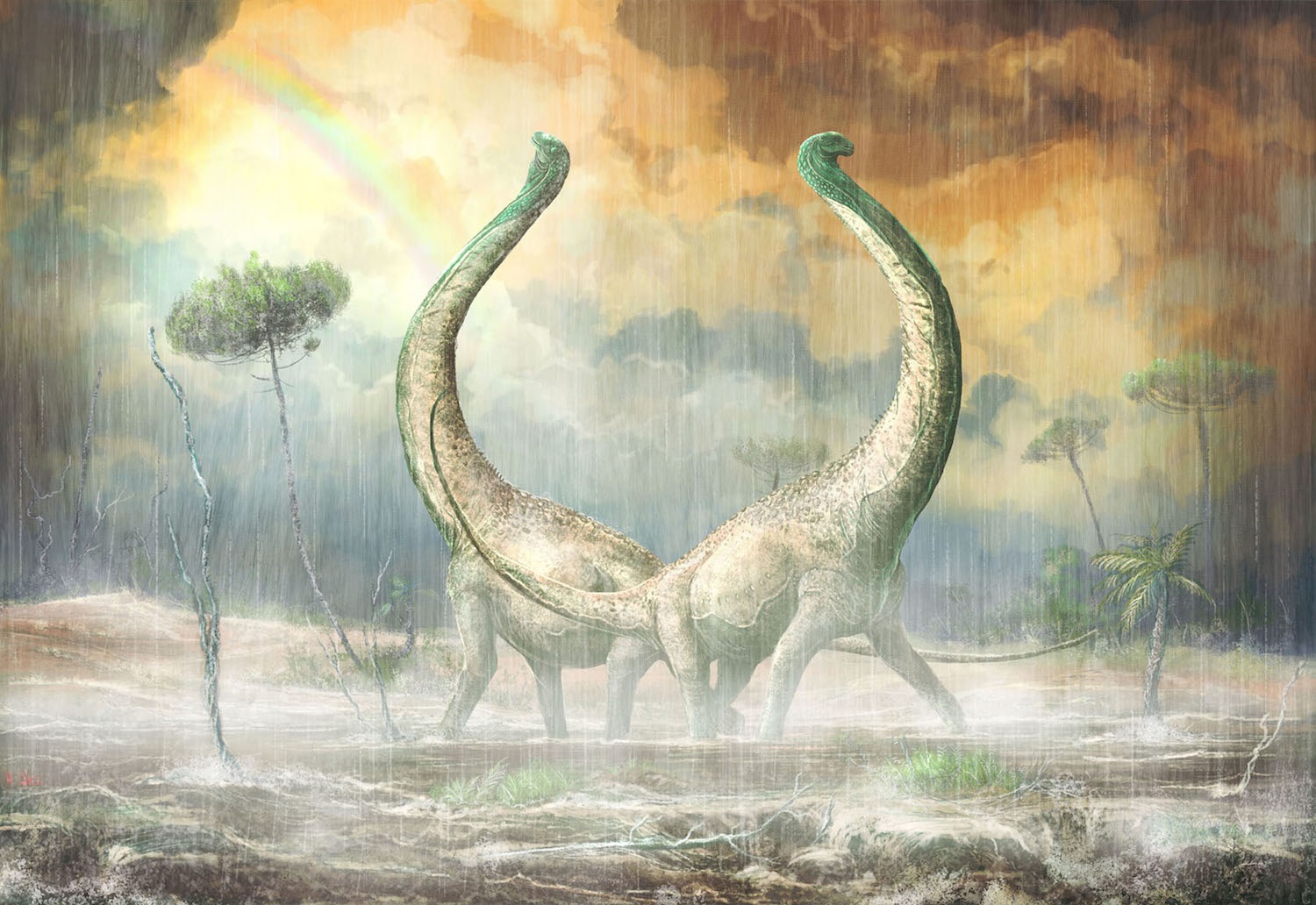Titanosaur the Size of a School Bus Had Heart-Shaped Tail Bones
A newfound dinosaur seems to wear its heart on its tail, according to paleontologists who found the enormous beast and realized this "hopeless romantic" had heart-shaped tail bones.
But this dinosaur, named Mnyamawamtuka moyowamkia, is extraordinary beyond its lovely tail. Paleontologists spent five years climbing a steep cliff in Tanzania so they could dig out all of the bus-size dinosaur's fossilized bones and teeth. And the discovery of this fairly complete, 100-million-year-old titanosaur (a group that includes the largest of the long-necked herbivores called sauropods) reveals more about how titanosaurs in Africa were related to their cousins in South America.
But really, each of the heart-shaped tail vertebra is the cherry on top of this discovery. [See Photos of the "Romantic" Titanosaur from Tanzania]
"It's pretty cute," said study lead researcher Eric Gorscak, a research associate at the Field Museum of Natural History in Chicago and an assistant professor at Midwestern University just outside Chicago. "[The vertebra] has these two prominent bumps on the top corners … and at the bottom it kind of comes down to a point, so it gives it that heart outline. It looks like the emoji of the heart."
Digging up the beast
Researchers discovered the first few M. moyowamkia fossils in 2004, when they were scouring the Mtuka River bed in southwest Tanzania for exposed fossils. Little is known about the Cretaceous period (145 million to 65 million years ago) of southern African, so the researchers were hoping for a big find.
And that's exactly what they got. The researchers spied some fossils embedded in the side of a cliff about 24 feet (7.3 meters) above the riverbed. For the next few field seasons, they returned with climbing equipment, and started chiseling away at the cliff face, excavating the Cretaceous-age bones.
In 2008, they had a windfall. The scientists were in a remote area, but they happened to make friends with a local contractor who was using heavy equipment to mine in the region. This contractor lent them his machinery, allowing the scientists to dig out the heaviest and deepest buried bones, said study co-researcher Patrick O'Connor, a professor of anatomy at Ohio University, who led the Tanzania excavation with support from the National Science Foundation.
Get the world’s most fascinating discoveries delivered straight to your inbox.
Still growing
Mnyamawamtuka moyowamkia (Mm-nya-ma-wah-mm-too-ka mm-oh-yo-wa-mm-key-ah), which means "beast of the Mtuka" and "heart of the tail," respectively, in Swahili, was a big beast, but it wasn't done growing yet.
The titanosaur's vertebrae (the backbones) aren't fully fused as an adult's would be, suggesting it was "still fairly young, like a teenager maybe," Gorscak told Live Science. It's unclear how it died, but the beast doesn't have discernible teeth marks on it from a predatory dinosaur, so it's unlikely it was anyone's dinner, Gorscak said. However it died, the dinosaur's body was buried quickly, which would explain why so many bones were preserved, he noted.
The teenage titanosaur likely weighed up to about 1.6 tons (1.5 metric tons), stood about 5 feet (1.5 m) tall at the hips and measured about 25 feet (7.6 m) long from head to tail, Gorscak and O'Connor said. [Gallery: Massive New Dinosaur Discovered in Sub-Saharan Africa]
Researchers are still learning what types of plants lived in Cretaceous southern Africa, but this is about the time that flowering plants (known as angiosperms) were taking off, and there were definitely ferns and palm-tree-like cycads. So, it's likely that M. moyowamkia munched on these to beef up, Gorscak said.
Titanosaur cousins
M. moyowamkia's anatomy suggests that it's closely related to other titanosaurs in Africa, including Malawisaurus, as well as early titanosaurs in South America, Gorscak said.
"Most of what we know about titanosaurs comes from South America," he said. "Mnyamawamtuka is kind of filling in that gap; titanosaurs were here in Africa during their early evolution, and they were just as weird as other titanosaurs elsewhere."
Geography may explain why the South American and African titanosaurs were similar. It took South America awhile to "unzip" from Africa (they were both once part of the supercontinent Gondwana), finally separating about 100 million to 95 million years ago, Gorscak said.
Moreover, South America and Africa unzipped south to north, "so, the southern part of Africa becomes semi-isolated because it's still connected to northern Africa, which is still connected to the northern part of South America and intermittently with Europe and Asia," Gorscak said. Even so, dinosaurs in these regions share anatomical similarities, he noted.
Titanosaurs lived on every continent on Earth, so it's important to find more species in regions that have few discoveries, including southern Africa, said Kristi Curry Rogers, a professor of geology at Macalester College in St. Paul, Minnesota, who was not involved with the study.
"Every new discovery of animals like Mnyamawamtuka adds data that clarify the picture of how dinosaur ecosystems evolved along with the continents they inhabited," Rogers told Live Science.
The study was published online today (Feb. 13) in the journal PLOS ONE.
- Photos: Meet Wade, the Long-Necked Dinosaur from Down Under
- Photos: Giant Sauropods Plodded Along in Scottish Lagoon
- Photos: School-Bus-Size Dinosaur Discovered in Egypt
Originally published on Live Science.

Laura is the managing editor at Live Science. She also runs the archaeology section and the Life's Little Mysteries series. Her work has appeared in The New York Times, Scholastic, Popular Science and Spectrum, a site on autism research. She has won multiple awards from the Society of Professional Journalists and the Washington Newspaper Publishers Association for her reporting at a weekly newspaper near Seattle. Laura holds a bachelor's degree in English literature and psychology from Washington University in St. Louis and a master's degree in science writing from NYU.



